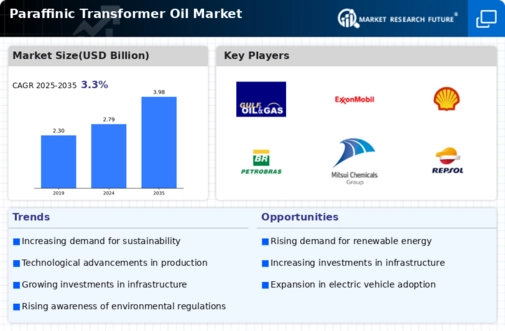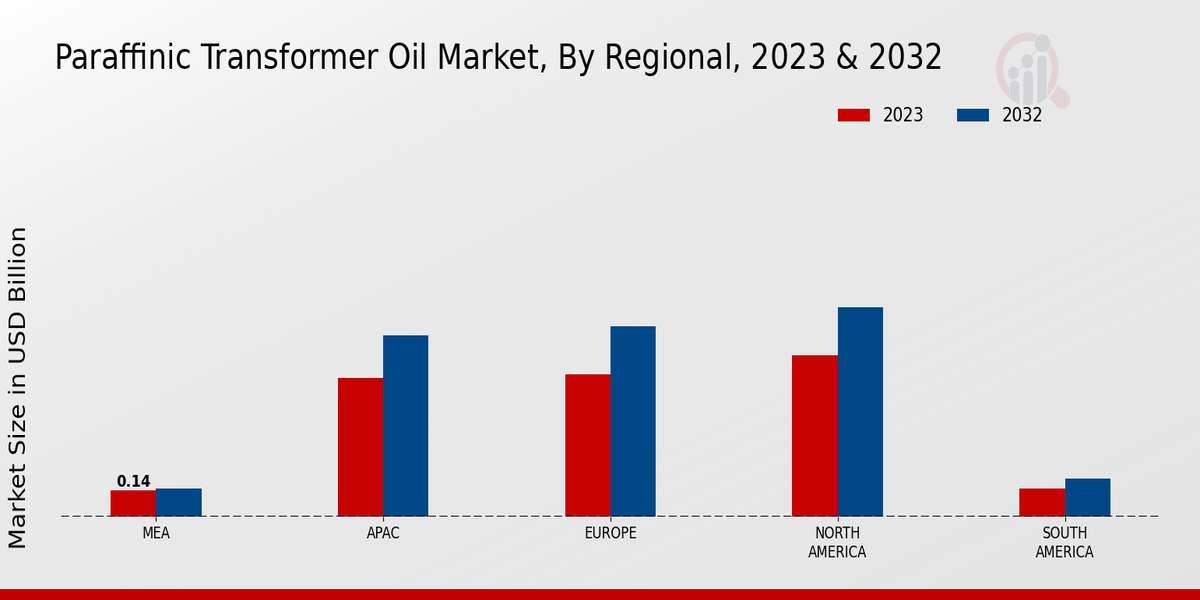Market Growth Projections
The Global Paraffinic Transformer Oil Market Industry is poised for substantial growth, with projections indicating a market value of 2.79 USD Billion in 2024 and an expected increase to 3.98 USD Billion by 2035. This growth trajectory reflects a compound annual growth rate of 3.28% from 2025 to 2035, suggesting a steady demand for paraffinic transformer oils driven by various factors such as technological advancements, regulatory changes, and the rising need for electricity. The market's expansion is indicative of the broader trends in energy consumption and infrastructure development, positioning paraffinic transformer oils as a critical component in the global energy landscape.
Growing Demand for Electricity
The increasing global demand for electricity is a primary driver of the Global Paraffinic Transformer Oil Market Industry. As urbanization and industrialization continue to rise, the need for reliable power supply becomes paramount. This surge in electricity consumption necessitates the installation of more transformers, which in turn drives the demand for paraffinic transformer oil. In 2024, the market is projected to reach 2.79 USD Billion, reflecting the essential role of transformer oil in ensuring efficient energy distribution. The trend is expected to persist, with projections indicating a market value of 3.98 USD Billion by 2035, highlighting the long-term growth potential in this sector.
Rising Investment in Renewable Energy
The global shift towards renewable energy sources is a crucial driver for the Global Paraffinic Transformer Oil Market Industry. As countries invest heavily in solar, wind, and hydroelectric power, the need for efficient energy transmission becomes increasingly important. Transformers play a vital role in integrating renewable energy into existing grids, necessitating the use of high-quality paraffinic transformer oils. This investment trend is expected to bolster the market, as renewable energy projects often require advanced transformer technologies that utilize paraffinic oils. The anticipated growth in this sector aligns with the overall market projections, indicating a promising future for paraffinic transformer oil.
Market Resilience Amid Economic Fluctuations
The Global Paraffinic Transformer Oil Market Industry demonstrates resilience amid economic fluctuations, which is a notable driver of its growth. Despite potential downturns in other sectors, the demand for electricity remains relatively stable, ensuring a consistent need for transformers and, consequently, transformer oil. This stability is particularly evident in developing regions where infrastructure expansion continues unabated. As economies recover and grow, the demand for reliable power supply will likely increase, further supporting the market. The projected growth from 2.79 USD Billion in 2024 to 3.98 USD Billion by 2035 underscores the market's ability to adapt and thrive in varying economic conditions.
Technological Advancements in Transformer Design
Technological advancements in transformer design are significantly influencing the Global Paraffinic Transformer Oil Market Industry. Innovations such as improved cooling systems and enhanced insulation materials are increasing the efficiency and lifespan of transformers. These advancements often require high-quality paraffinic transformer oils that can withstand elevated temperatures and provide superior performance. As utilities and manufacturers adopt these new technologies, the demand for specialized transformer oils is expected to rise. This trend not only supports the growth of the market but also encourages further research and development in oil formulations, ensuring that the industry remains competitive and responsive to evolving needs.
Environmental Regulations Favoring Paraffinic Oils
Stringent environmental regulations are increasingly favoring the use of paraffinic transformer oils over traditional mineral oils. The Global Paraffinic Transformer Oil Market Industry benefits from this shift, as paraffinic oils are known for their lower environmental impact and better biodegradability. Regulatory bodies are promoting the use of eco-friendly alternatives to reduce the carbon footprint associated with energy production and distribution. This trend is likely to enhance the market's growth trajectory, as manufacturers and utilities seek compliant solutions. The anticipated compound annual growth rate of 3.28% from 2025 to 2035 indicates a robust market response to these regulatory pressures.













